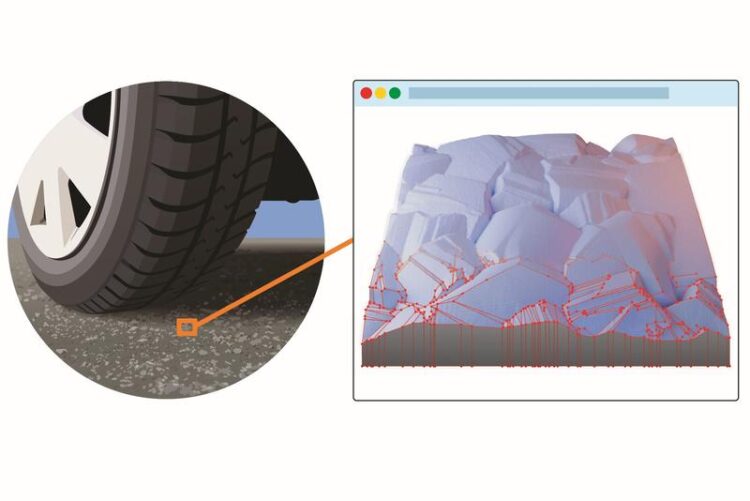New software platform advances understanding of the surface finish of manufactured components

The contact.engineering platform allows users to upload, analyze and share measurements of surface roughness.
Credit: Rick Henkel, Lucas Frérot
Scientists from University of Freiburg, Germany, and the University of Pittsburgh develop platform that combines measurements of surface topography in a digital twin.
Scientists from the University of Freiburg, Germany, and the University of Pittsburgh have developed a software platform that facilitates and standardizes the analysis of surfaces. The contact.engineering platform enables users to create a digital twin of a surface and thus to help predict, for example, how quickly it wears out, how well it conducts heat, or how well it adheres to other materials. The team included Michael Röttger from the Department of Microsystems Engineering, Lars Pastewka and Antoine Sanner from the Department of Microsystems Engineering and the University of Freiburg’s Cluster of Excellence livMatS, and Tevis Jacobs from the Department of Mechanical Engineering and Materials Science at the University of Pittsburgh’s Swanson School of Engineering. They presented the software platform in the journal Surface Topography: Metrology and Properties (doi: 10.1088/2051-672X/ac860a).
Topography influences material properties
All engineered materials have surface roughness, even if they appear smooth when seen with the naked eye. Viewed under a microscope, they resemble the surfaces of a mountain landscape. “It is of particular interest, in both industrial applications and scientific research, to have precise knowledge of a surface’s topography, as this influences properties like the adhesion, friction, wettability, and durability of the material,” says Pastewka.
Saving time and cost in manufacturing
Manufacturers must carefully control the surface finish of, for example, automobiles or medical devices to ensure proper performance of the final application. At present, the optimal surface finish is found primarily by a trial-and-error process, where a series of components are made with different machining practices and then their properties are tested to determine which is best. This is a slow and costly process. “It would be far more efficient to use scientific models to design the optimal topography for a given application, but this is not possible at present,” says Jacobs. “It would require scientific advancements in linking topography to properties, and technical advancements in measuring and describing a surface.”
The contact.engineering platform facilitates both of these advances and standardizes the procedure: It automatically integrates the various data from different tools, corrects measurement errors, and uses the data to create a digital twin of the surface. The platform calculates statistical metrics and applies mechanical models to the surfaces, helping to predict behavior. “The users can thus identify which topographical features influence which properties. This allows a systematic optimization of finishing processes,” says Pastewka.
Facilitating open science
The software platform also serves as a database on which users can share their measurements with colleagues or collaborators. Users can also choose to make their surface measurements available to the public. When they publish the data, a digital object identifier (DOI) is generated that can be referenced in scientific publications.
“We are continually developing contact.engineering and would like to add even more analysis tools, for example for the chemical composition of surfaces,” says Pastewka. “The goal is to provide users with a digital twin that is as comprehensive as possible. That’s why we also welcome suggestions for improvements to the software platform from users in industry and research.”
The development of contact.engineering was funded from the European Research Council and the US National Science Foundation, as well as from the University of Freiburg’s Cluster of Excellence Living, Adaptive, and Energy-autonomous Materials Systems (livMatS).
Journal: Surface Topography Metrology and Properties
DOI: 10.1088/2051-672X/ac860a
Method of Research: Computational simulation/modeling
Subject of Research: Not applicable
Article Title: Contact.engineering—Create, analyze and publish digital surface twins from topography measurements across many scales
Article Publication Date: 14-Sep-2022
Media Contacts
Paul Kovach
University of Pittsburgh
paulkovach@pitt.edu
Sonja Seidel
University of Freiburg
sonja.seidel@livmats.uni-freiburg.de
Office: +49 (0)761/203-95361
All latest news from the category: Materials Sciences
Materials management deals with the research, development, manufacturing and processing of raw and industrial materials. Key aspects here are biological and medical issues, which play an increasingly important role in this field.
innovations-report offers in-depth articles related to the development and application of materials and the structure and properties of new materials.
Newest articles

Superradiant atoms could push the boundaries of how precisely time can be measured
Superradiant atoms can help us measure time more precisely than ever. In a new study, researchers from the University of Copenhagen present a new method for measuring the time interval,…

Ion thermoelectric conversion devices for near room temperature
The electrode sheet of the thermoelectric device consists of ionic hydrogel, which is sandwiched between the electrodes to form, and the Prussian blue on the electrode undergoes a redox reaction…

Zap Energy achieves 37-million-degree temperatures in a compact device
New publication reports record electron temperatures for a small-scale, sheared-flow-stabilized Z-pinch fusion device. In the nine decades since humans first produced fusion reactions, only a few fusion technologies have demonstrated…





















